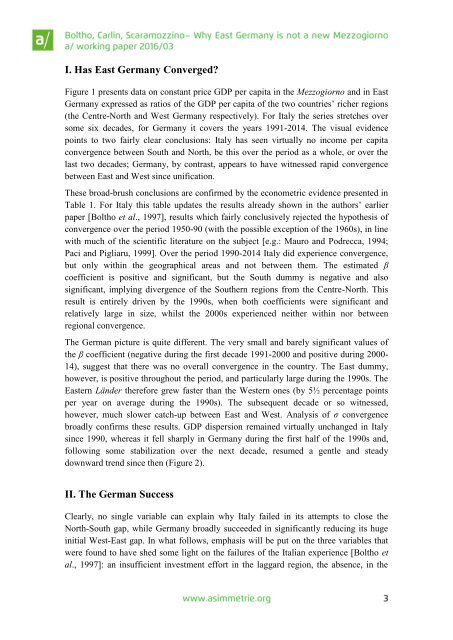n?u=RePEc:ais:wpaper:1603&r=his
n?u=RePEc:ais:wpaper:1603&r=his
n?u=RePEc:ais:wpaper:1603&r=his
You also want an ePaper? Increase the reach of your titles
YUMPU automatically turns print PDFs into web optimized ePapers that Google loves.
I. Has East Germany Converged?<br />
Figure 1 presents data on constant price GDP per capita in the Mezzogiorno and in East<br />
Germany expressed as ratios of the GDP per capita of the two countries’ richer regions<br />
(the Centre-North and West Germany respectively). For Italy the series stretches over<br />
some six decades, for Germany it covers the years 1991-2014. The visual evidence<br />
points to two fairly clear conclusions: Italy has seen virtually no income per capita<br />
convergence between South and North, be this over the period as a whole, or over the<br />
last two decades; Germany, by contrast, appears to have witnessed rapid convergence<br />
between East and West since unification.<br />
These broad-brush conclusions are confirmed by the econometric evidence presented in<br />
Table 1. For Italy this table updates the results already shown in the authors’ earlier<br />
paper [Boltho et al., 1997], results which fairly conclusively rejected the hypothesis of<br />
convergence over the period 1950-90 (with the possible exception of the 1960s), in line<br />
with much of the scientific literature on the subject [e.g.: Mauro and Podrecca, 1994;<br />
Paci and Pigliaru, 1999]. Over the period 1990-2014 Italy did experience convergence,<br />
but only within the geographical areas and not between them. The estimated β<br />
coefficient is positive and significant, but the South dummy is negative and also<br />
significant, implying divergence of the Southern regions from the Centre-North. This<br />
result is entirely driven by the 1990s, when both coefficients were significant and<br />
relatively large in size, whilst the 2000s experienced neither within nor between<br />
regional convergence.<br />
The German picture is quite different. The very small and barely significant values of<br />
the β coefficient (negative during the first decade 1991-2000 and positive during 2000-<br />
14), suggest that there was no overall convergence in the country. The East dummy,<br />
however, is positive throughout the period, and particularly large during the 1990s. The<br />
Eastern Länder therefore grew faster than the Western ones (by 5½ percentage points<br />
per year on average during the 1990s). The subsequent decade or so witnessed,<br />
however, much slower catch-up between East and West. Analysis of σ convergence<br />
broadly confirms these results. GDP dispersion remained virtually unchanged in Italy<br />
since 1990, whereas it fell sharply in Germany during the first half of the 1990s and,<br />
following some stabilization over the next decade, resumed a gentle and steady<br />
downward trend since then (Figure 2).<br />
II. The German Success<br />
Clearly, no single variable can explain why Italy failed in its attempts to close the<br />
North-South gap, while Germany broadly succeeded in significantly reducing its huge<br />
initial West-East gap. In what follows, emphasis will be put on the three variables that<br />
were found to have shed some light on the failures of the Italian experience [Boltho et<br />
al., 1997]: an insufficient investment effort in the laggard region, the absence, in the






